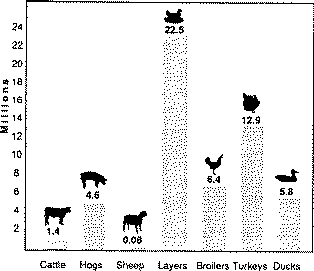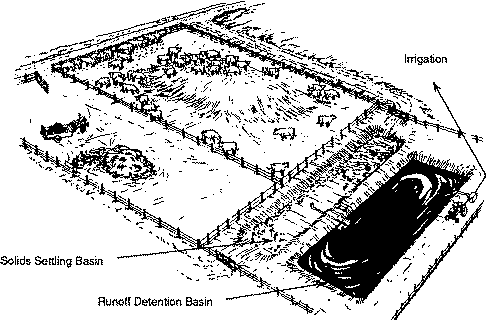
WQ-77/90
Animal agriculture in Indiana makes a significant contribution to the supply of meat, milk and eggs for consumption in our nation and abroad and supplies a considerable amount of revenue to the state. In 1988, sale of livestock and livestock products in Indiana equalled $1.74 billion. Lives- tock sales made up 42.5 percent of the $4.1 billion total of all agricultural commodities in the state (Figure 1).

Animal manures are a natural by-product of the livestock industry. Animal wastes must be handled, stored, utilized and/or disposed of in an efficient way while maintaining or improving the quality of the environment. Many factors affect the pollution potential of animal waste. Nutrient con- tent of animal waste varies with collection, storage and application methods. Climate conditions also contribute to the effect animal waste might have on water supplies.
Possible contaminants from animal waste include: nitrogen, phosphorus, inorganic salts, carbon compounds and microorganisms. This bulletin discusses possible water pollution problems from pasture and feedlot systems and the management practices needed protect water supplies.
Pasture and range systems still make up a major portion of livestock production in Indiana. To illustrate: feeder calves are produced almost exclusively from cow-calf enterprises on pasture and range systems; a sub- stantial portion of swine production (both feeder pig and farrow-to-finish) is still accomplished on pasture; most dairy farms utilize pasture when sea- sonal conditions permit; and sheep production is mainly a range and pasture operation.
Grazing animals deposit manure directly on the land in pasture manage- ment systems. Though a pasture may be relatively large, manure may become concentrated near feeding and watering areas. Often near flowing streams, these areas can quickly become barren of plant cover, increasing the possi- bility of contaminated runoff.
There is very little research on the extent of non-point pollution from pasture systems. From the few studies reported, streams near pastures and ponds where cattle had access, showed only a slight increase in bacteria and carbon compound levels.
Good management is the best insurance against pollution of water from pasture or range systems of livestock production. "Good management" guide- lines include the following:
1. Prevent manure buildup in any one area by maintaining an adequate
land-to-livestock ratio.
2. Maintain a highly productive forage on the land to slow runoff,
entrap manure and utilize nutrients.
3. Plan a rotation system of grazing to prevent overgrazing and soil
erosion.
4. Locate feeders and waterers a reasonable distance from streams and
water courses. Move them to new locations before livestock wear
paths by repeated trampling.
5. Provide shade in summer, using trees or artificial shelters, to
reduce the need for animals to enter water for heat relief.
6. Fence animals away from ponds and streams if domestic water sup-
plies use surface water.
Open feedlots are a potential point source of water pollution. Point source pollution problems can occur when an open feedlot makes no provisions for runoff control or if manure management facilities are mismanaged, poorly designed or constructed.
To protect Indiana's waterways, the state legislature in 1971 enacted the Indiana Confined Feeding Control Law requiring operations above certain sizes, or those identified as polluters, to obtain approval for their manure management systems. Approval is the responsibility of the Indiana Department of Environmental Management (IDEM). The law requires livestock operations, subject to the law, provide: (1) adequate storage capacity for feedlot runoff and manure to permit timely disposal on the land, and (2) adequate equipment and land for manure disposal.
Confinement livestock producers who follow current available technology in designing and managing their operations should have no trouble complying with current regulations.
In open feedlots, large amounts of manure are deposited and accumulated in a relatively small area. There is the potential for nutrients and microorganisms beneath earthen feedlots to leach into ground water supplies.
Research has shown virtually no nitrate or other nutrients leach beneath the feedlot, as long as animals are present and an established manure pack is left undisturbed. The reasons being (1) the manure pack forms an impervious layer, (2) conditions are not right for the manure nitrogen to be changed into a leachable nitrate form and (3) very little water movement occurs through the compacted soil beneath the feedlot.
Piles of partly decomposed manure must occasionally be removed from earthen feedlots. Care must be taken to avoid disturbing the 3-4 inches of compacted manure near the soil surface. Removal of the manure pack at the soil surface can allow nitrate movement into ground water.
Unpaved lots should have a uniform slope of about 4-6 percent. Dirt mounds provide livestock with dry areas and some protection from the wind. Mounds increase the surface area of the lot and reduce the chances of stand- ing water. Mud and erosion problems can be minimized by using a construction filter fabric covered with 4-6 inches of large gravel and soil.
Contaminated runoff should be absorbed in a grassed filter channel or collected in a holding pond. A settling basin must be placed between the feedlot and filter channel to remove 60-75 percent of the manure solids (Fig- ure 2). Removing solid waste helps reduce odors from holding ponds and allows easy removal of the waste water by irrigation equipment. The feedlot size, number of animals and soil type, determines if a filter channel and holding pond can be used. The runoff collected in the holding pond will be applied to fields by irrigation.

Good management practices will decrease the risk of contaminating water supplies. Consider the following recommendations for pasture and feedlot production systems:
1. Maintain a stocking rate appropriate for the animal specie and size
of pasture or feedlot.
2. Locate pastures on well-drained soil with productive plant cover to
utilize nutrients and prevent runoff.
3. Pastures and feedlots should be at least 100 feet from domestic water
supplies and old wells.
4. Use grass filter terraces to channel runoff from feeding, watering
and shelter areas away from surface water in pastures. In feedlots,
divert the uncontaminated surface water away from the lot to prevent
overloading of the waste control system.
5. Keep roof gutters clean and in working order. Direct clean water
from downspouts away from the feedlot and waste storage.
For further information on livestock production and water quality contact your county Cooperative Extension Office. The following bulletins in the WQ series may be helpful:
WQ 1 "Water Testing Laboratories" WQ 8 "Animal Agriculture's Effect on Water Quality Waste Storage"
ID-101 "Utilization of Animal Manure as Fertilizer"
ID-114 "Runoff Control Systems for Open Livestock Feedlots"
ID-122 "Solid Waste Handling for Dairy Operations"
AS-422 "Suggestions for Preparing a Zoning Ordinance to Regulate and Pro-
tect Confinement Feeding Operations"
PIH-35 "Legal Guidelines for Swine Waste Management"
PIH-67 "Swine Waste Alternatives"
PIH-105 "Scraper Systems for Removing Manure from Swine Facilities"
MWPS-18 "Livestock Waste Facilities Handbook"
CES-227 "How and Where to Get a Livestock Manure Analysis"
_____________________________________________________________________________
| |
| Indiana Confined Feeding Control Law |
| |
| Your county Cooperative Extension Office can provide you with |
| information on the Confined Feeding Law. You may also contact the |
| Indiana Department of Environmental Management |
| 105 S. Meridian Street, Indianapolis, IN 46225 |
| 317/243-5036 |
|___________________________________________________________________________|
Editor: Cheri L. Janssen, Department of Agronomy
Cooperative Extension work in Agriculture and Home Economics, state of Indiana, Purdue University, and U.S. Department of Agriculture cooperating; H. A. Wadsworth, Director, West Lafayette, IN. Issued in furtherance of the acts of May 8 and June 30, 1914. The Cooperative Extension Service of Purdue University is an affirmative action/equal opportunity institution.